Car Ignition Coil Tester
793,50 ر.س The price does not include Value Added Tax (VAT), which will be calculated during checkout.
Feel the Precision Diagnostic with KM20 Car Ignition Coil Tester. Measure RPM, spark voltage, & burn time. Easy to use, no ground wire needed.
KM20 Multisystem Automotive Ignition System Analyzer: Diagnostic Power in Your Hands
Move your ignition system diagnostic to a new level of precision and efficiency with Coil Tester tool KM20, The Multisystem Ignition Analyzer. Designed specifically for automotive and Car repair shop, this cutting-edge car ignition coil tester offers an indispensable tool for accurately identifying and analyzing ignition system performance. Thanks to its advanced technology, you can now measure the speed of each cylinder in a car engine, as well as measure the ignition voltage in the high-voltage ignition coil and the fuel injection time in each cylinder.
Key Features:
- Comprehensive Measurement:
- The device allows you to measure engine RPM, spark voltage, and spark burn time, Automotive coil testing, giving you a complete picture of ignition system performance.
- Advanced Technology:
- The device utilizes precise control technology that ensures accurate measurements and ease of use.
- Practical Design:
- The device features an induction-based design, eliminating the need to dismantle any engine parts, thus saving time and effort.
- Dynamic Display:
- The device displays data dynamically, allowing you to monitor performance changes in real time.
- Range Identification:
- The device displays the maximum and minimum readings, helping you quickly identify potential problems.
- Ease of Use:
- The device does not require ground wire connections, making it easy to use even for beginners.
- KM20 :
- The ideal choice for repair shops striving for excellence in automotive diagnostics.
Important Safety Information
- Operating Environment:
- This device is intended for indoor use only, within temperatures ranging from 0°C to 40°C, and altitudes up to 2000 meters.
- Safe Operation:
- Always follow the safety and operating instructions provided in this manual. Failure to do so may compromise the device’s safety features.
- Pre-Use Inspection:
- Do not use this device, the capacitive pickup, or the flexible probe if they appear damaged or if you suspect any malfunction.
- Avoiding Hazards:
- Keep the device, capacitive pickup, and flexible probe away from moving parts (e.g., fans, belts) and hot objects (e.g., exhaust pipe, muffler, catalytic converter) during use to prevent personal injury or damage.
- Electrical Safety:
- Do not connect or apply more than 42V DC or any AC current to the capacitive pickup or flexible probe. Exercise caution when working on circuits exceeding 60V DC or 25V AC to avoid electrical shock.
- Battery Safety:
- Do not operate the device with the battery cover removed.
- Input Limits:
- Never exceed the specified input limits to prevent electrical shock or damage to the device.
Technical Specifications
- Display:
- 128 x 64 digit LCD screen
- Refresh Rate:
- Update 3 times per second (LCD)
- Ignition System Compatibility:
- Coil-on-plug (COP), coil-near-plug (CNP), DIS, conventional, and magneto coils.
- Engine Cycles:
- Work on 2-cycle, 4-cycle, and DIS (distributor less ignition system)
- Power:
- Alkaline 9V battery
- Auto Power Off:
- After 3 minutes of inactivity
- Battery Life:
- Approximately 20 working hours (with alkaline battery)
- Probe Length:
- Long 35 cm (including capacitive pickup)
- Dimensions:
- Compact design with165 x 100 x 32 mm (without antenna)
- Weight:
- Approximately 0.363 kg (including battery)
- Included Accessories:
- Padded hard carrying case, user manual, rubber holster, 1x 9V alkaline battery.
Note: Failure to adhere to these precautions or exceeding the limitations specified above may result in personal injury or permanent damage to the device or the vehicle being tested.
Electrical Specifications
The specifications below are based on a standard 23°C environment. Slight variations may occur between different devices and temperatures. To prevent personal injury or damage to the instrument, do not exceed the specified maximum input voltage.
- Function Measurement Range Accuracy/Repetitively Input Characteristics
- RPM 200 to 19999 RPM (2 & 4 cycles, DIS) 0.5% ± 1 LSD Input Impedance: 100KΩ + 1.5 nF (Min.)<br>Input Protection: ±42 VDC Max.
- Spark KV 0 to 50 Kv 3% ± 1 LSD
- Spark Burn Time 0 to 10 ms ±0.1ms
Instrument Description
Fig. 1 – Instrument Description
- Capacitive Pickup
- Flexible Probe
- Protective Rubber Holster
- LCD Display
- Power/Reset Button
- F2 Button
- Ignition System Button
- F1/Calibrate Button
- Engine Cycles Button
LCD Display Description
Fig. 2 – LCD Display
- Low Battery Indicator:
- This indicator alerts you when the battery voltage is below the recommended minimum, signaling the need for a replacement.
-
Number of Cycles:
-
Displays the selected number of engine cycles (strokes): 2, 4, or DIS.
-
Ignition System:
-
In the Car Ignition Tester Displays you can chose ignition system measurement mode:
- (SPW) for Spark Plug Wire, (COP) for Coil on Plug and Coil near Plug.
-
-
Spark Detected:
-
A flashing high voltage symbol indicates spark detection in the ignition system tester.
-
-
Secondary Display A:
-
Pressing (F2) shows the maximum reading, RPM, or spark K-Volt (depending on settings), along with the selected measurement units and/or functions.
-
-
Secondary Display B:
-
Pressing (F2) displays the minimum reading, RPM, or spark burn time, in accordance with the chosen settings and units.
-
-
Main Display:
-
The (F1/Calibrate) button toggles the main display between engine RPM, spark K-Volt, or spark burn time.
-
-
Functions and Measurement Units:
-
Shows the units and/or functions for the main display. The following table illustrates the available options:
- Display Function Measurement Units
- RPM Tachometer RPM (Revolutions per minute)
- Burn Time mS Spark plug burn time mS (Milliseconds)
- Spark KVolt Spark plug peak voltage KVolt (1000 x Volt)
-
Notes:
If the battery is low but still allows operation, the indicator will remain displayed until a new battery is installed.
If the device powers off immediately after turning on, the battery is below the absolute minimum and must be replaced to prevent malfunction.
KM20 Multisystem Automotive Ignition Coil Analyzer: Comprehensive Engine Diagnostics with Compu-car 2-Years Warranty & Tech Support
The KM20 Multisystem Ignition Analyzer is a powerful tool designed to pinpoint issues in various engine ignition systems. Backed by Compu-car’s 2-year warranty and expert technical support, you can diagnose with confidence.
Main display screen and secondary operations
Fig.3- Examples of Main and Secondary Functions combinations
Intuitive Button Operation for Efficient Analysis
- Power ON/OFF & Reset:
- Press & hold (1 sec): Turn the analyzer ON.
- Press & hold (3 sec): Turn the analyzer OFF.
- Quick press: Reset maximum/minimum and capture values.
Note: KM20 automatically powers off after 3 minutes of inactivity to conserve battery life.
- Ignition System:
- Choose the mode that matches your engine’s ignition system:
- SPW (Spark Plug Wire): For systems with high-voltage spark plug wires (conventional, magneto, distributor less, waste spark).
- COP (Coil on Plug): For systems with coils mounted near or on the spark plugs.
- Choose the mode that matches your engine’s ignition system:
- Engine Cycles:
- Select the number of cycles for your engine:
- SPW mode: 2 cycles, 4 cycles, or DIS (distributor less/waste spark).
- COP mode: 2 cycles or 4 cycles.
- Select the number of cycles for your engine:
- F1 / Calibrate:
- Quick press: Cycle through displayed measurements (RPM, spark burn time, spark peak voltage).
- Press & hold (3 sec): Enter COP module type for automatic calibration (COP mode only).
- F2:
- Quick press: Toggle secondary displays (between two additional measurements or max/min readings).
- Press & hold (3 sec): Turn the display backlight on or off.
Why Choose KM20 Car Ignition Analyzer?
- Versatile: Handles a wide range of ignition systems.
- User-friendly: Easy-to-understand buttons and clear display.
- Reliable: Backed by Compu-car’s 2-year warranty and technical support.
Get in touch with Compu-car today to learn more about how the KM20 Car Ignition Diagnostic tool can revolutionize your engine diagnostics.
Spark Plug Wire Ignition Systems: Step-by-Step Diagnostics with the KM20
Fig. 4 – Capacitive pick-up on spark plug wire
- Power On: Turn on your KM20 Multisystem Ignition Analyzer.
- Select SPW Mode: Confirm or switch to SPW (Spark Plug Wire) mode using the Ignition System button.
- Set Engine Cycles: Press the Engine Cycles button to match the number of cycles of the engine you’re testing (2, 4, or DIS).
- Choose Measurement: Select the primary value you want to see on the main display: RPM, spark burn time, or spark KVolt.
- Configure Secondary Display: Choose to show either the maximum/minimum readings of your main measurement or the two complementary measurements.
- Measure: Place the capacitive pick-up over a spark plug wire and observe the readings. (See Fig. 4)
Important Tips for Accurate Spark Plug Wire Measurements:
- Consistent Positioning:
- Keep the capacitive pick-up at the same relative position for each spark plug wire measurement. A 90° angle or parallel to the wire is recommended.
- RPM and Burn Time Flexibility:
- These measurements aren’t as sensitive to the pick-up’s exact position but ensure it can detect the signal.
- Minimizing Interference:
- If wires are bundled together, separate them during testing to avoid false readings.
Fig. 5 – Avoiding interference by shielding nearby ignition coils
KV Adjust Function: Matching Your Readings
In SPW mode, you can calibrate the KM20’s spark plug wire peak voltage scale to align with other tools like ignition scopes:
- Turn On & Select KVolt: Power up the KM20 and select Spark KVolt as your main measurement.
- Enter KV Adjust Mode: Press and hold the Engine Cycles button until you see KV Scale and a percentage value on the display.
- Adjust Scale: While holding the Engine Cycles button, use the F2 (increase) or F1/Calibrate (decrease) buttons to finetune the scale.
By following these steps and tips, you’ll maximize the diagnostic power of your KM20 Multisystem Ignition Analyzer for spark plug wire ignition systems.
Additional Functions: Expanding Your Diagnostic Toolkit:
KM20 Ignition Analyzer offers even more features to enhance your diagnostic process
- Minimum and Maximum Functions (COP and SPW Modes)
- Track the extremes of your measurements with ease
- View Min/Max:
- Press the F2 button to display the minimum and maximum values of your selected main measurement.
- Reset:
- To clear the min/max readings, simply press the Power/Reset button momentarily. This is also done automatically when the analyzer is turned on.
- Spark KVolt Calibration (COP Mode Only):
- Ensure accurate spark KVolt readings for COP and CNP ignition systems
- Why Calibrate:
- Calibration optimizes measurement parameters for your specific ignition module type, compensating for variations in waveform and signal strength.
- How to Calibrate:
- Follow the steps outlined in the Measuring COP and CNP Ignition Systems section above. (See Fig. 7)
- Calibration Reference:
- Once calibrated, subsequent spark KVolt readings will be relative to the value obtained during the procedure.
- Impact on Other Measurements:
- Calibration affects only spark KVolt readings. RPM and spark burn time measurements are absolute and remain unaffected.
Important Notes on Calibration:
- Default Baseline:
- The analyzer displays 10.0 spark KVolt immediately after calibration.
- Non-Comparable Readings:
- Spark KVolt values obtained before and after recalibration may not be directly comparable.
- Uncalibrated Readings:
- The analyzer will display a false 0.0 Spark KVolt reading in COP/CNP mode if not calibrated.
By utilizing these additional functions, you’ll gain a deeper understanding of your engine’s performance and unlock the full potential of your KM20 Multisystem Ignition Analyzer.
Application Information: Interpreting Results for Accurate Diagnosis
Using your KM20 to its fullest potential involves understanding the measurements and diagnosing potential issues:
- Taking Measurements
- Select Ignition System: Follow the instructions in Measurement Procedures to choose the appropriate mode for your engine.
- Observe Readings: Note the spark burn time and spark KVolt values on the display. Slight fluctuations are normal, reflecting real-time changes in the ignition system.
- Record & Compare: Take note of the maximum, minimum, and average readings for each spark plug wire or ignition module. Look for any readings significantly higher or lower than the average.
- Vary Engine Speed: Test at idle and normal operating temperature, then gradually increase RPM up to 2000-2500 (without exceeding the redline). Maintain consistent engine speed during testing, using the KM20’s tachometer function.
- Diagnosing with Spark Burn Time and Spark KVolt
Some variation between cylinders is expected, but significant differences may point to issues:
- RPM & Spark Burn Time:
- These are absolute measurements and should be interpreted directly.
- Spark KVolt:
- This is relative, used to compare ignition modules or spark plug wires within the same engine.
- COP Calibration:
- In COP mode, calibrate spark KVolt on one module before comparing readings across cylinders.
- SPW Placement:
- In SPW mode, the capacitive pick-up’s position on the wire can affect readings due to internal wire resistance. Closer to the distributor/DIS coil typically yields higher voltage readings.
Common Causes of Abnormal Readings:
- Long Burn Time:
- Spark plug issues (short circuit, dirt, small gap)
- Damaged insulator/boot
- Rich mixture
- Low cylinder compression
- Short Burn Time:
- Worn spark plug or wide gap.
- Damaged/loose spark plug connector.
- High resistance in ignition coil primary circuit
- Lean mixture
- Low Spark KVolt:
- Spark plug issues
- Damaged insulator/boot
- Broken sparks plug wire core.
- Short circuit/disconnection in distributor/DIS coil circuit.
- Rich mixture
- Low cylinder compression
- High Spark KVolt:
- Worn spark plug or wide gap.
- Damaged/loose spark plug connector.
- Broken sparks plug wire core.
- Lean mixture
By understanding these common causes and interpreting your KM20’s readings accurately, you can quickly diagnose and address ignition system problems, ensuring optimal engine performance.
Measuring COP and CNP Ignition Systems
Fig. 6-Capacitive pickup on coil on plug module
- Power On & Select COP: Turn on Car Coil Tester KM20 and press the Ignition System button to select COP mode.
- Set Engine Cycles: Choose 2 or 4 cycles based on your engine type.
- Choose Measurement: Pick the primary value to display (RPM, spark burn time, or spark KVolt).
- Calibrate (Optional): For accurate spark KVolt readings, calibrate the automotive coil tester to your specific COP module type.
- Measure: Connect the flexible probe to the ignition system tester and place its tip near the ignition coil or spark plug. (See Fig. 5)
- Observe & Compare: Monitor readings for each cylinder, noting any significant deviations from the average.
Calibration Steps for COP Mode:
- Access Calibration: Press and hold the F1/Calibrate button for 3 seconds.
- Select Module Type: Use the F1/Calibrate and F2 buttons to navigate through the available COP module types.
- Confirm Selection: Press the Engine Cycles button to confirm your choice.
- Calibration Complete: Ignition system tester will briefly display (Calibrating) and then show 10.0 spark KVolt, indicating successful calibration.
Fig. 7 – Display during calibration
Remember, calibration is crucial for accurate spark KVolt measurements in COP mode.
Enhance Your Diagnostics with the KM20 Ignition Analyzer
The KM20 Multisystem Ignition Analyzer empowers you to:
- Diagnose Accurately:
- Identify ignition system issues with precision.
- Save Time & Money:
- Streamline your diagnostic process and avoid unnecessary repairs.
- Boost Efficiency:
- Optimize engine performance and improve customer satisfaction.
Invest in KZYEE KM20 Automotive ignition tester today and experience the difference!
Contact Compu-car for expert guidance and support
For further assistance or inquiries about the KM20 Automotive ignition tester, reach out to Compu-car. Our knowledgeable team is ready to help you make the most of this powerful diagnostic tool.
1 review for Car Ignition Coil Tester
Clear filtersShow reviews in all languages (2)


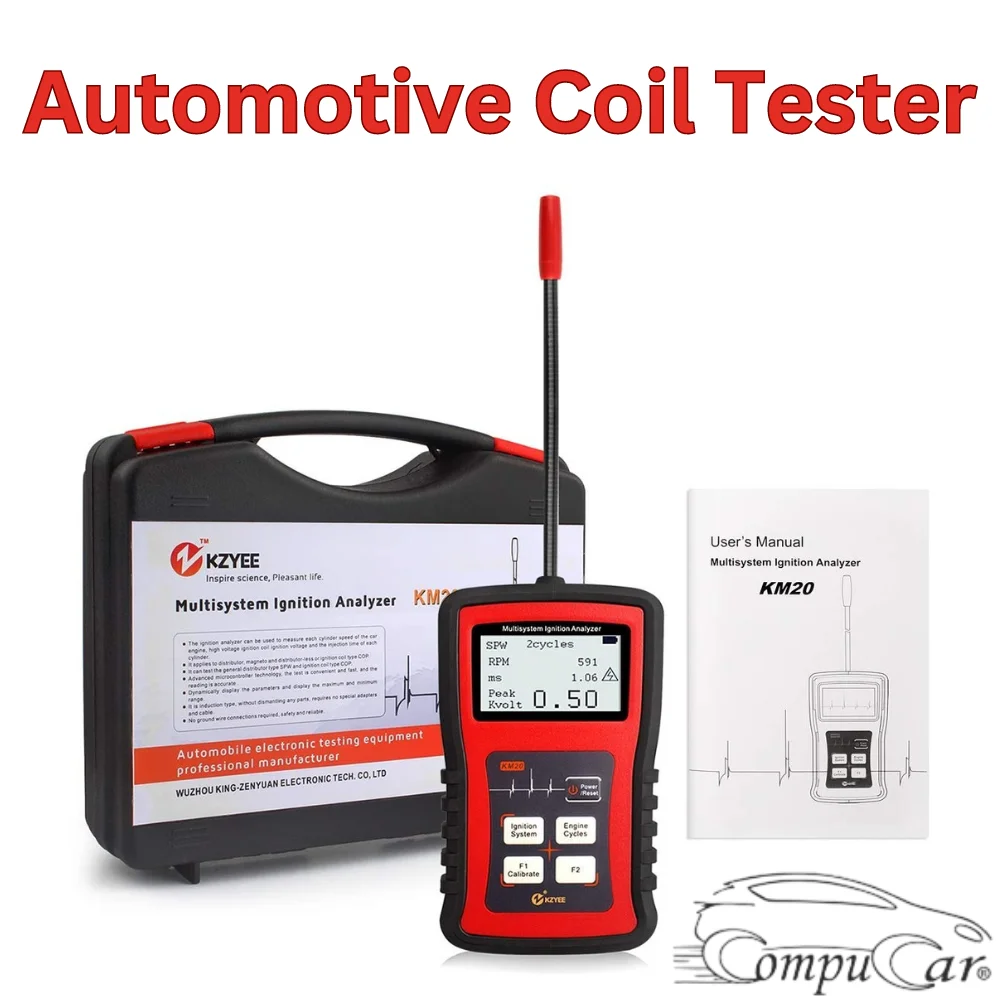
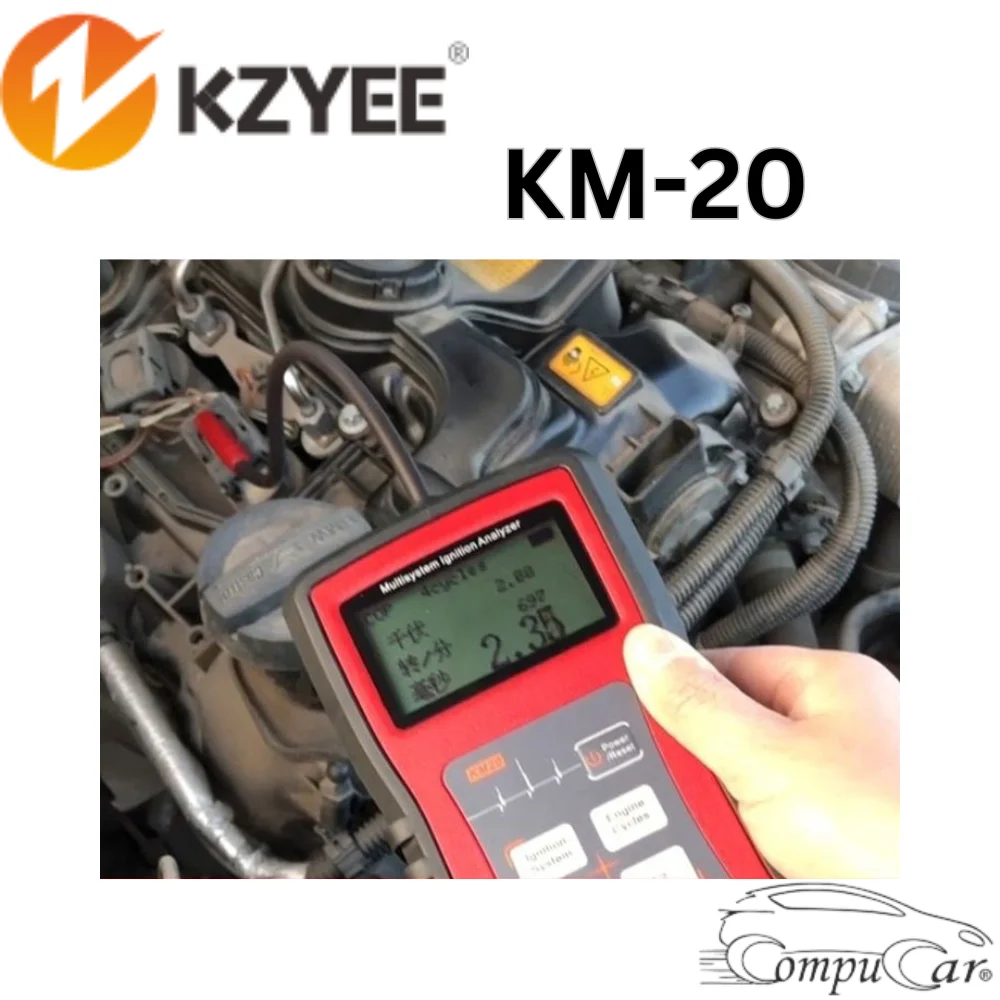
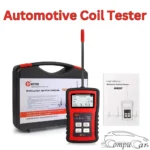
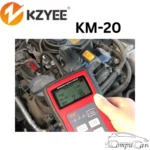

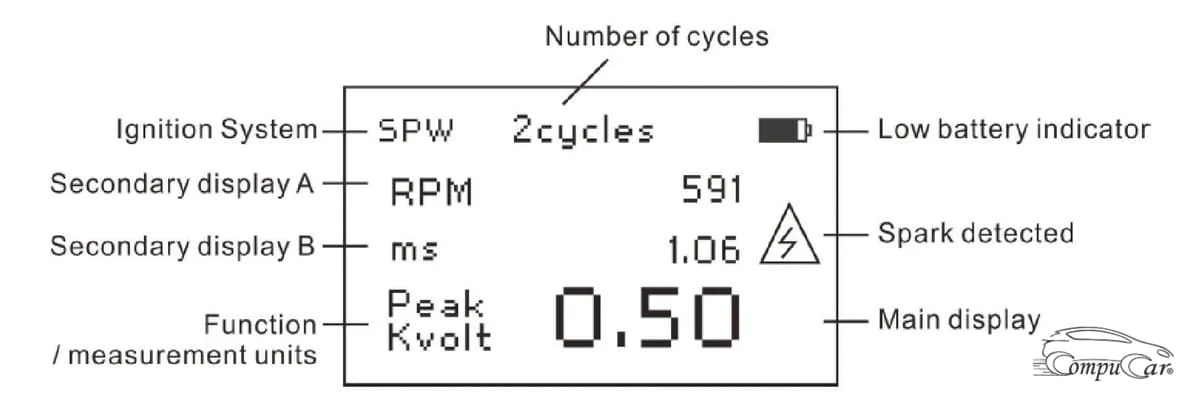

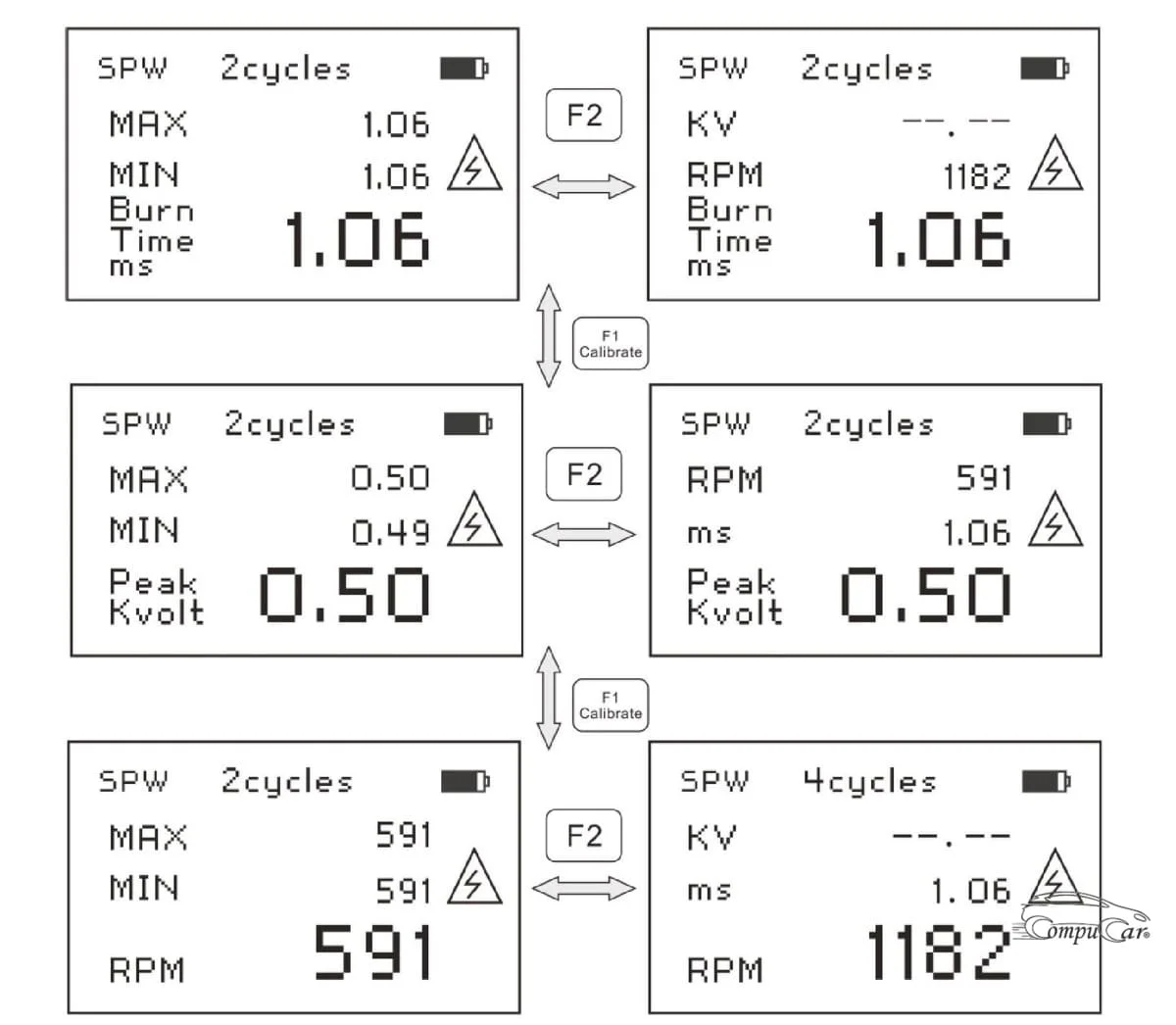

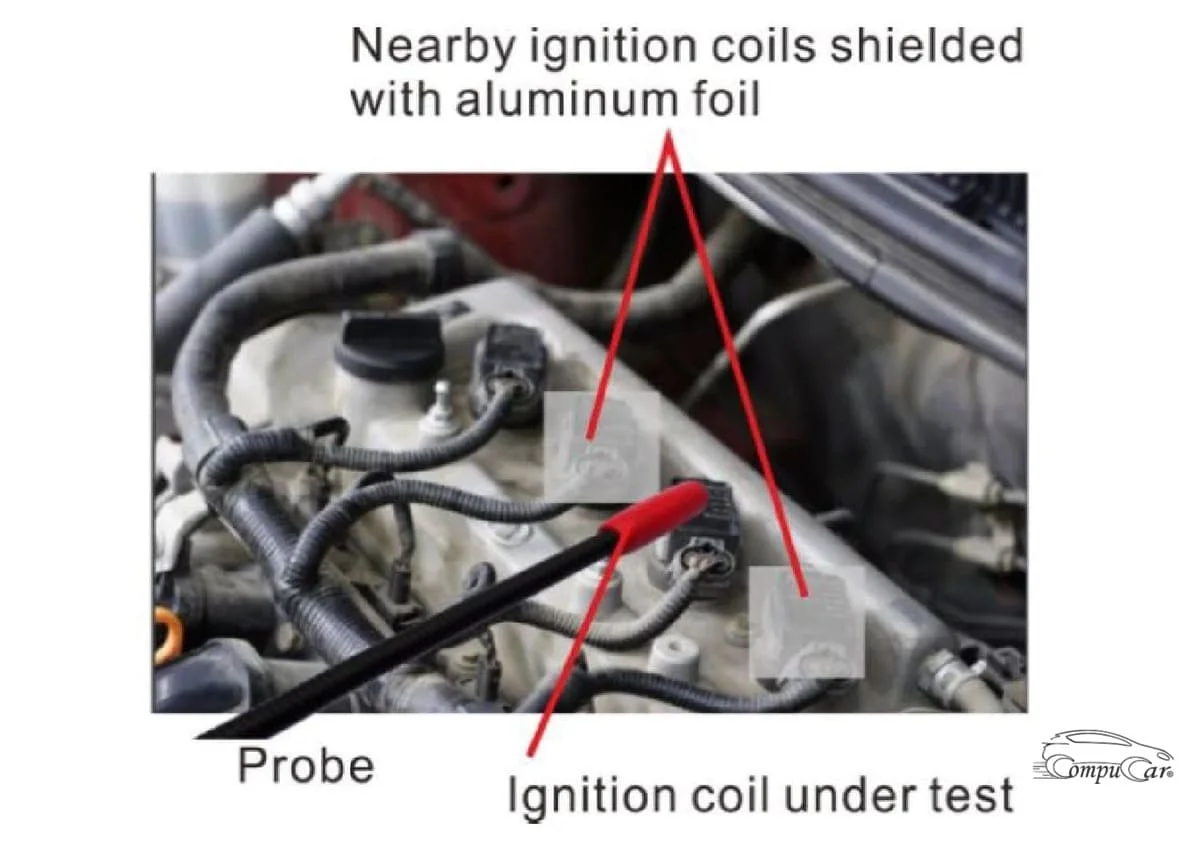
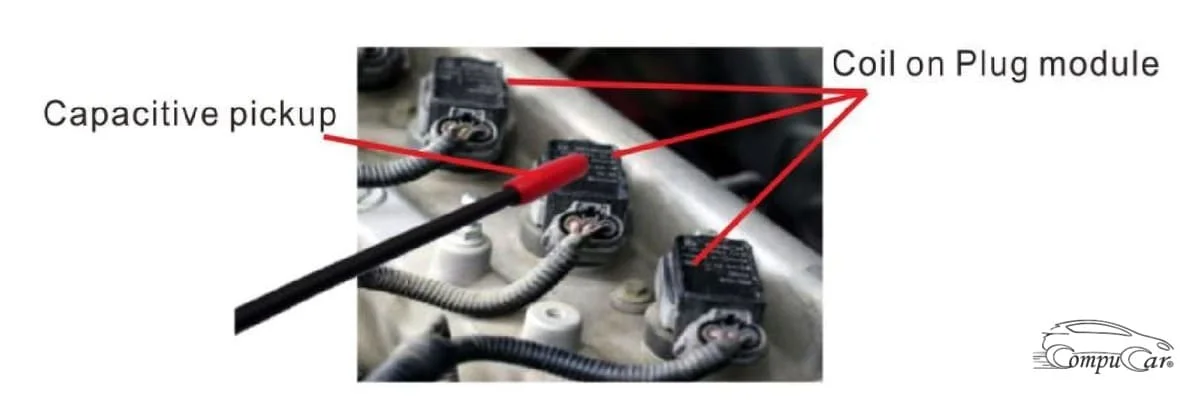

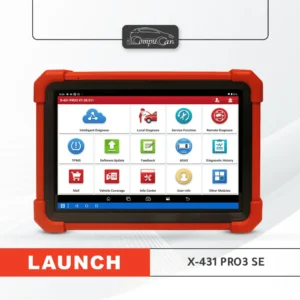




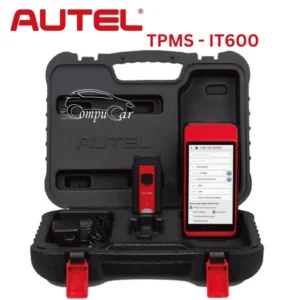
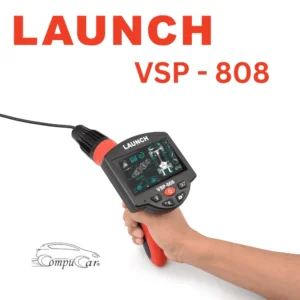

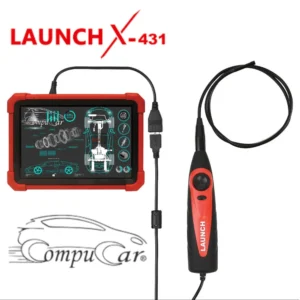
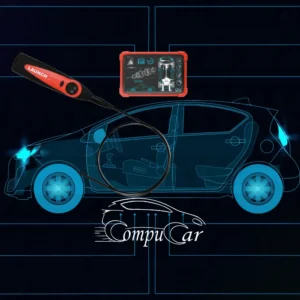
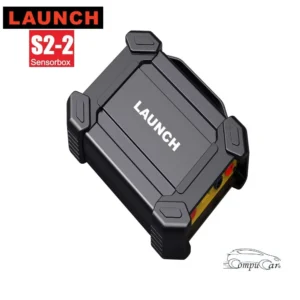
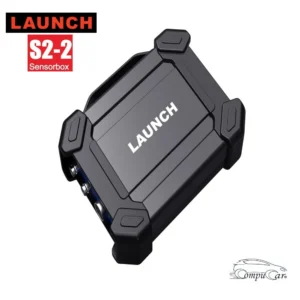
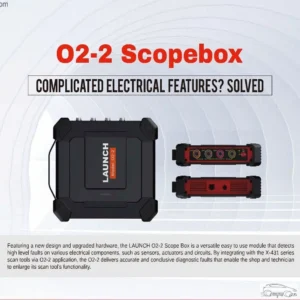
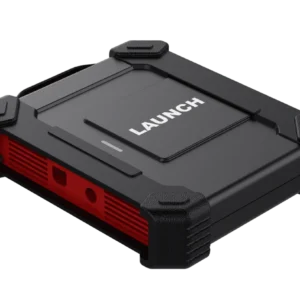
John Alto –
Great tools
Review link on Google Map
https://maps.app.goo.gl/3rxf4TU29EiLjPbV6